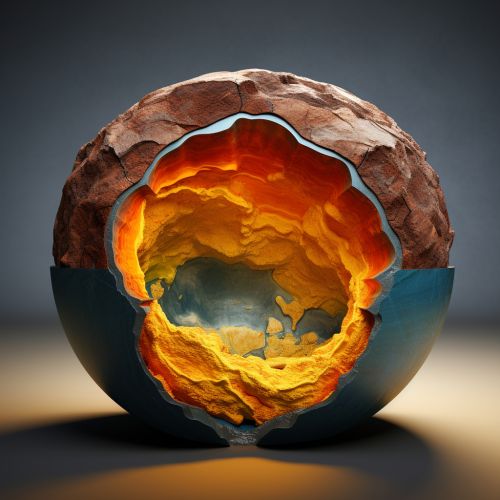Earth's core
Structure of the Earth's Core
The Earth's core is the innermost part of our planet, composed primarily of iron and nickel. It is divided into two distinct parts: the inner core and the outer core. The inner core is a solid sphere with a radius of approximately 1,220 kilometers (760 miles), while the outer core, which envelopes the inner core, is a shell with a thickness of about 2,200 kilometers (1,367 miles).


Composition and Physical Properties
The core is composed predominantly of iron (85-88%), along with nickel and other light elements such as sulfur and oxygen. The outer core, unlike the inner core, is not under enough pressure to be solid and is believed to be composed of hot, molten iron and nickel. This molten outer core creates the Earth's magnetic field through a process called the dynamo effect.
The temperature in the core ranges from approximately 4,000 degrees Celsius (7,200 degrees Fahrenheit) in the outer core to over 6,000 degrees Celsius (10,800 degrees Fahrenheit) in the inner core. The pressure at the Earth's core ranges from about 3.3 million atmospheres in the outer core to over 3.6 million atmospheres in the inner core.
Discovery and Study
The existence of the Earth's core was first proposed by Danish seismologist Inge Lehmann in 1936, based on observations of seismic waves from earthquakes. Seismic waves are the waves of energy caused by the sudden breaking of rock within the earth or an explosion. They are the waves we feel during an earthquake. Lehmann discovered that primary seismic waves (P-waves) traveled faster than expected when they passed through certain parts of the Earth, suggesting these regions were made of something denser than rock.
The Earth's Magnetic Field
The Earth's magnetic field is generated within the outer core by the dynamo effect. This process involves the convection of molten iron and nickel, combined with the rotation of the Earth, which generates an electric current and, consequently, a magnetic field. This magnetic field extends outwards from the Earth and interacts with the solar wind, a stream of charged particles emanating from the Sun. The interaction between the Earth's magnetic field and the solar wind results in the aurora borealis and aurora australis.
Impact on Plate Tectonics
The Earth's core plays a crucial role in the movement of tectonic plates. The heat from the core creates convection currents in the mantle. These currents cause the molten rock in the mantle to rise, cool, and then sink back down, creating a cycle. This movement of the mantle is what drives the movement of the tectonic plates in the Earth's crust.
